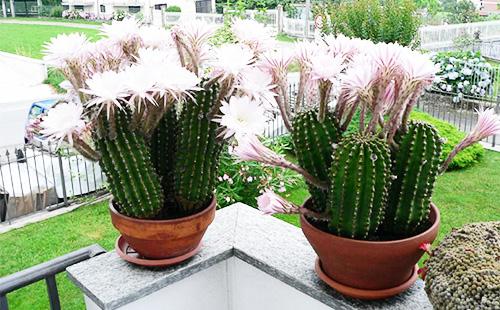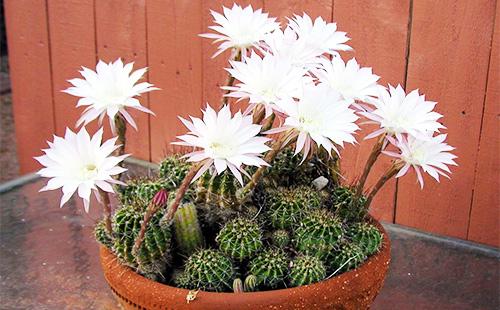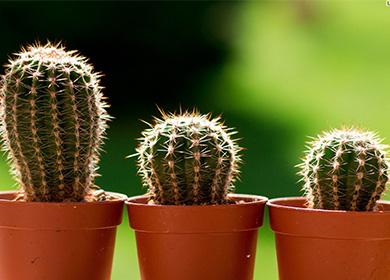The content of the article
The plant can be found on Bolivian, Argentinean, Uruguayan, Brazilian lands. Often they are found in the valleys, foothills of the Andes. Under natural conditions, the culture is surrounded by many children.
Representatives of the genus are common in home gardening. In European countries, they began to appear on window sills since 1837. From the Greek, “echinus” is a hedgehog, “opsis” is similar. Plants look like animals.
Description
Young plants have the shape of a ball. Over the years, they stretch out or take on the shape of a pillar. Be sure to have sharp ribs on the stem, which can be light or dark green in color. A powerful root system develops horizontally and is located on the surface. Areoles can carry stiff, short or long spines.
There are species that bloom either at night or during the day. Flowers of different sizes and colors - from white to deep purple or bright orange. Their number depends on the age of the culture. “Oldies” can produce up to 25 pieces. In most cases, flowering lasts only one to three days. The fruits are egg-shaped.
Types for indoor floriculture
Amateur growers use indoor hybrids, which were obtained as a result of random pollination of natural species. There are quite a lot of them and everything is difficult to list. The table shows the most common cacti in home floriculture.
Table - Popular "domesticated" types of echinopsis
| View | Distinctive features |
|---|---|
| Edged | - There can be up to 14 faces on a cactus ball; - diameter - up to 20 cm, height - up to 30 cm; - thorns of different lengths; - white, light pink flowers |
| Hooked | - Dark green stem of spherical or oblong shape; - diameter 8-10 cm; - ribbed surface; - yellow flowers with a specific smell |
| Airies | - Dark green spherical stem with sides; - soft pink flowers; - many shoots on the sides |
| Golden (frost resistant) | - An elongated, cylindrical shape; - diameter up to 10 cm; - green ribbed surface with needles; - flowers of yellow, light orange color |
| Echinopsis mamillosa | - Round shape with pointed edges; - white, light pink flowers; - fruits of a round shape, green tint |
| Partitioned | - A rounded elongated stem 15-20 cm high; - flowers of a light pink color |
| Hausha | - Stems up to 1 m, branch at the base; - red or red-yellow flowers |
Basic care
Most members of the genus are easy to grow. Therefore, they are chosen by both experienced gardeners and beginners. All hedgehogs need is a few simple rules.
Light and place
Cactus is very fond of light. Even in conditions of direct exposure to ultraviolet radiation, it adapts if it is gradually accustomed to the rays. It is recommended to place it on the eastern and western windowsills. In hot summers, lighting is regulated: at lunchtime, if the plant is on the south side, shading is needed.So you can avoid sunburn.
Temperature
In summer, comfortable conditions for the "hedgehog" 22-27 ° C. At night, the pot can be taken out to the balcony, loggia - lowering the temperature favorably affects the development of the plant. It is recommended to avoid rainfall. In autumn, starting in October, the temperature should be 6-12 ° C. It is also supported in the winter. During this period, growth stops. From November to March, the plant rests, gaining strength for flowering after sleep. In the cold season, the cactus can tolerate short-term short-term frosts.

Humidity and watering
"Hedgehog" feels comfortable in a dry microclimate, so there are no special requirements for air humidity. Its tough skin prevents the rapid evaporation of moisture. Periodically, it can be kept in the shower, cleaning from dust and dirt. Before spraying, cover the soil with polyethylene.
In spring and summer, watering is carried out every two to three days. The topsoil should dry. In winter, it is better to practically stop the procedure - do it no more than once a month. Soft and settled water is used. How to understand when the soil needs to be moistened? A sign of drying out of the soil is the subsidence of the plant.
Top dressing
During the period of active growth, the plant is fed with fertilizer for cacti once a month. You can use other additives, but with a minimum amount of nitrogen. Its excess can lead to rotting of the roots. The optimal ratio of substances is the following composition: one part of nitrogen, two parts of phosphorus and potassium. After the fall, additional food is not needed.
Soil and transplant
Nutrient soil is used for neutral acidity cacti. The mixture should pass air well. At home, the substrate is prepared from expanded clay, sand, peat, deciduous or sod land. Sometimes humus is added. Without fail, a drainage layer is laid. To prevent root rot, a small amount of charcoal is added to the soil.
"Hedgehog" needs to be transplanted in February. (Young plants must not be touched for two or three years). A few days before the procedure, it is not watered. An adult plant is removed from the old flowerpot and transferred to a new one. The first watering is carried out in a week. During this time, the roots will be able to heal and will be immune to rot.
Rejuvenation
You can rejuvenate an old plant that has lost its decorative properties. These are cacti 12-15 years old. To do this, cut off the upper part of the "hedgehog." It is dried within 10-12 days. Next, the slice is placed in the substrate for rooting. The stump left after the procedure will be able to shoot.
Bloom
To achieve long flowering echinopsis, flower growers conduct various experiments. Some argue that it is better to take children from plants that have bloomed at least once. Otherwise, the new cactus will focus on the formation of processes. Others contain “hedgehogs” under extreme conditions: low temperature, dry soil (one or two irrigation over the entire winter).
Breeding
In order to plant a cactus, children or seeds are used. Sowing seeds is carried out in the spring. Unlike the maternal method, seed propagation allows you to get a new plant with brighter flowers.If children are used, then the resulting specimens gradually lose their species qualities, rarely bloom.
Seeds
- Pre-soak the seeds in warm water or a solution of potassium permanganate.
- Planted in wet soil (sheet soil, clean sand, crushed charcoal).
- Tanks are covered with polyethylene.
- Crops are kept warm (17-20 ° C), regularly sprayed, ventilated. (Friendly shoots should appear within 15-20 days).
- A pick is carried out when the plants reach the size of large peas.
Kids
- Shoots are separated from the main stem.
- They are dried for several days and planted in soil in separate containers.
- The shoots are slightly pressed into the fine sand.
- They are waiting for rooting for one to two weeks. After that, the pots are carefully placed in a permanent place.
Growing problems
The appearance of any problems is the result of improper care. What can flower growers face?
- Lack of flowering. Reason: warm, wet wintering. Or in the summer there is not enough recharge and hydration.
- The plant stretched out. The loss of decorative qualities is due to a lack of light. Dry air and excessive watering in winter lead to deformation. The thorns turn pale, become thin, there are no flowers.
- Stains. In most cases, are the result of excessive watering. For the purpose of treatment, we normalize watering, cut out the affected areas.

Pests and diseases
Cactus is usually resistant to insects and diseases. The plant is rarely affected:
- spider mite - white coating;
- mealybug - not only on the surface, but also in the roots;
- scale shield - brown spots.
With a weak lesion, insects are removed mechanically. They are collected with a brush dipped in a soap or alcohol solution. If it is strong, pests are destroyed by special medicines. Before using the grower, you need to know about the dosage and method of spraying. Often, processing is carried out several times.
Among possible diseases, root or dry rot, late blight, rust, spotting can be distinguished. Fungicides will help. Disease prevention is to create the most optimal conditions.
Providing the "hedgehog" comfortable conditions, you can witness a vivid spectacle. In most cases, flowers “gramophone” begin to open in the evening. Donate several hours of sleep and watch the real miracle happening on the windowsill.

